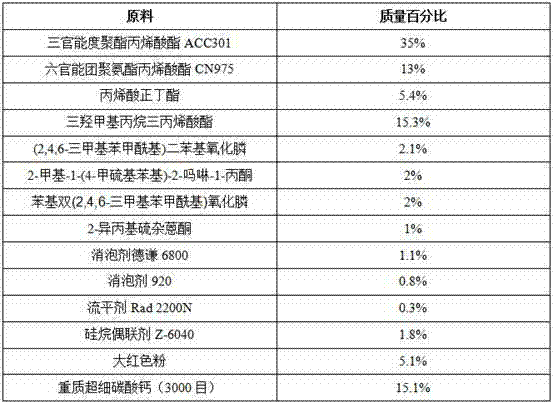LED-UV photocurable screen printing halogen-free glass ink
A glass ink, light curing technology, applied in the direction of ink, household appliances, applications, etc., can solve the problems of high energy consumption, high energy consumption, environmental pollution, etc., and achieve the effect of small operating area
- Summary
- Abstract
- Description
- Claims
- Application Information
AI Technical Summary
Problems solved by technology
Method used
Image
Examples
Embodiment 1
[0032] A LED-UV photocurable screen printing halogen-free glass ink, the formula is as follows:
[0033] Table 1:
[0034]
[0035] The above formula has been pre-dispersed, the fineness after grinding is 7.5μm, and the viscosity is 2750mPa.s / 25℃.
Embodiment 2
[0037] A LED-UV photocurable screen printing halogen-free glass ink, the formula is as follows:
[0038] Table 2:
[0039]
[0040] The above formula is pre-dispersed, the fineness after grinding is 10μm, and the viscosity is 3200mPa.s / 25℃.
Embodiment 3
[0042] A LED-UV photocurable screen printing halogen-free glass ink, the formula is as follows:
[0043] table 3:
[0044]
[0045] The above formula is pre-dispersed, the fineness after grinding is 10μm, and the viscosity is 3050mPa.s / 25℃.
PUM
 Login to View More
Login to View More Abstract
Description
Claims
Application Information
 Login to View More
Login to View More - R&D
- Intellectual Property
- Life Sciences
- Materials
- Tech Scout
- Unparalleled Data Quality
- Higher Quality Content
- 60% Fewer Hallucinations
Browse by: Latest US Patents, China's latest patents, Technical Efficacy Thesaurus, Application Domain, Technology Topic, Popular Technical Reports.
© 2025 PatSnap. All rights reserved.Legal|Privacy policy|Modern Slavery Act Transparency Statement|Sitemap|About US| Contact US: help@patsnap.com



